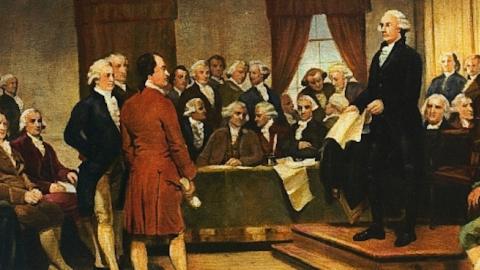Since November 8, Democrats have been searching for a scapegoat. Hillary Clinton’s defeat couldn't possibly signal voters' rejection of the liberal policies that Barack Obama advanced and Clinton vowed to continue, so progressives are on a quest to find the real culprit. They have thus far floated James Comey, Vladimir Putin, "fake news," and the rampant racism of a citizenry that twice elected a black president. More consequentially, they are taking aim at one of the cornerstones of our republic: the Electoral College.
From the Constitutional Convention's opening days, delegates debated how the president should be selected. Yet their decision to have that office chosen by electoral vote was one of the last decisions they made. In one enduringly important respect, the system they chose is a departure from a national popular vote. That is the Electoral College's weighting mechanism, which grants each state a particular say in the overall result. This remains just as good an idea as it was in 1789. Indeed, in nine key ways, the test of time has proven the Electoral College to be an ever better idea than the convention delegates realized:
1. It requires a candidate to have cross-sectional support. The Electoral College makes it hard for a candidate to win who is not supported by large swaths of the country, from sea to shining sea. In this way, it is a nod to—yes—diversity. A presidential candidate cannot easily prevail by dominating just a few heavily populated regions or municipalities. He or she must appeal to the nation as a whole.
Barack Obama was something of an exception, as he twice won despite losing the vast majority of counties and winning only five states not bordering either coast or the Great Lakes. But Hillary Clinton stretched this parochial strategy to the breaking point. Just 20 years after her husband won almost half of all counties nationwide, Hillary won less than one county for every five won by Donald Trump. One could drive from coast to coast without going through a single Hillary county, while the farthest one could get from the coastal states without going through a Trump county would be from the Pacific to Nevada, or from the Atlantic to Pennsylvania or New Hampshire. Not coincidentally, that's about as far inland as candidates would regularly venture under a national popular vote, as they would spend most of their time flying back and forth between the I-95 and I-5 corridors.
2. It almost always produces a clear winner. A national popular vote would at times result in razor-thin margins, but the electoral vote has rarely been close. Over the past century, the presidency has been decided by fewer than 100 electoral votes only five times and by fewer than 50 only twice. (It was decided by 77 this year.) The median margin of victory across the past 100 years has been a whopping 277 electoral votes. This has certainly added to the president's perceived legitimacy.
3. It avoids the specter of a nationwide recount. To this day, no one really knows who won the popular vote between John F. Kennedy and Richard Nixon—a contest Kennedy nevertheless won by 84 electoral votes. (Apart from the dead voters in Cook County, Illinois, it comes down to how the popular vote is counted in Alabama, where people cast their votes for delegates, not candidates.) Imagine if such an election were to require a nationwide recount, with the results of that recount potentially being disputed. Without hyperbole, a constitutional crisis could easily follow. And the more divided the nation gets, the more dire such a scenario would become.
4. It reduces the influence of fraud. With many Democratic-leaning states adamantly refusing to check voters' IDs, or relying almost exclusively on mail-in ballots, a nationwide popular vote would be an open invitation to fraud. Even if more Democratic-leaning states started ID'ing voters, many of them—such as California—give driver's licenses to illegal immigrants, so checking their IDs would largely be pointless. Such states would pad their votes and illegitimately alter the national tally.
5. It reduces the incentive to depart from Election Day. All other things being equal, the longer a state keeps open its polls, the more votes will be cast in that state. A national popular vote would give states a perverse incentive to turn Election Day into Election Week, Fortnight, Month, or even Year—the better to influence the national tally. Meanwhile, states that stick to the time-honored notion of Election Day, a day of civic pride and shared citizenship, would reduce their influence on the election.
6. It reflects federalism. We are the United States of America, not a nation without state designations or borders. It is altogether appropriate that states should matter in determining who will be president.
7. It is weighted just like Congress. If the Electoral College is illegitimate, then so is the Senate, with its equal-state representation (the only part of the Constitution that the Constitution itself says cannot be amended). When critics of the electoral vote complain about its departure from the supposedly sacrosanct principle of "one person, one vote," they seem oblivious to the fact that each state's number of electoral votes is simply equal to its number of representatives (population-based) plus its number of senators (two per state). In other words, representation in Congress "violates" this same principle—and by exactly the same amount as the Electoral College does. Smaller states didn't want to be entirely dominated by larger states in the union they all agreed to form. The same motivation underlies the Electoral College.
8. Its history is not tainted. Showing great ignorance of the Constitution's history and structure, the New York Times editorial board recently claimed that the Electoral College is more than just a vestige of the founding era; it is a living symbol of America's original sin. When slavery was the law of the land, a direct popular vote would have disadvantaged the Southern states, with their large disenfranchised populations. Counting those men and women as three-fifths of a white person, as the Constitution originally did, gave the slave states more electoral votes.
This is rich. Aside from the fact that slavery was never "the law of the land" (but was the law in the South), the Electoral College had nothing to do with that peculiar institution. That fractional calculation pertained to the House of Representatives, in which states' representation was originally based on their number of free persons plus three-fifths of all slaves, with the three-fifths clause a holdover from the Articles of Confederation. Is the House, then, "a living symbol of America's original sin"? If it's not—and it's not—then the Electoral College certainly isn't. Moreover, the three-fifths clause has been a dead letter since 1865.
9. It abides by the principle of majority rule. A candidate cannot win the electoral vote with a mere plurality but must obtain a majority. Advocates of a national popular vote want to abandon the principle of majority rule and allow a plurality to prevail. They would like Hillary Clinton (who won 48 percent of the popular vote) to be declared president despite her failing to win a majority of counties, states, or votes.
The Electoral College has not only served us well but is needed more than ever in a country that's increasingly divided. Maybe instead of calling for abandoning this time-honored method of choosing the president, liberals should simply pick better candidates. Hillary Clinton managed to do something no one had done for 140 years: win the popular vote by 2 points yet still fail to win the electoral vote. Her ineptitude is no reason to question the Founders' brilliance.















